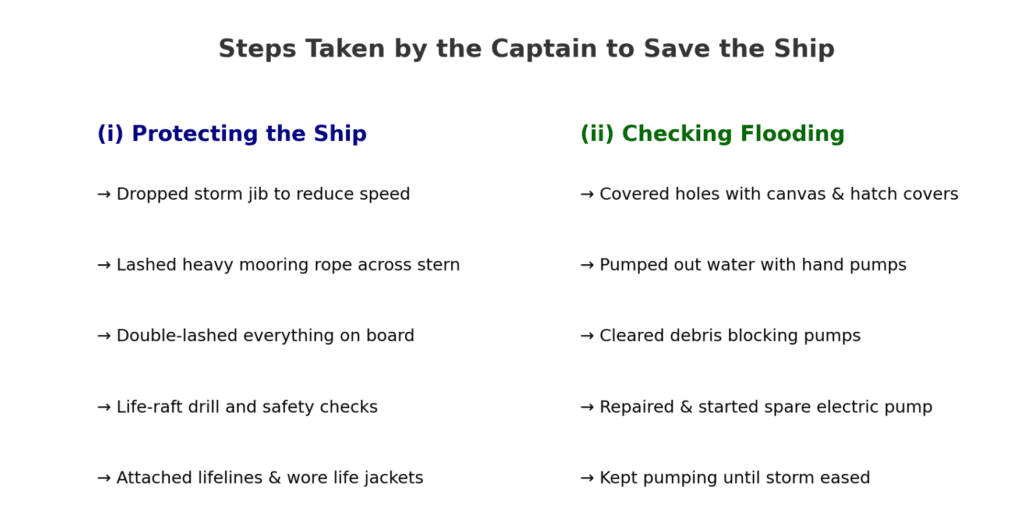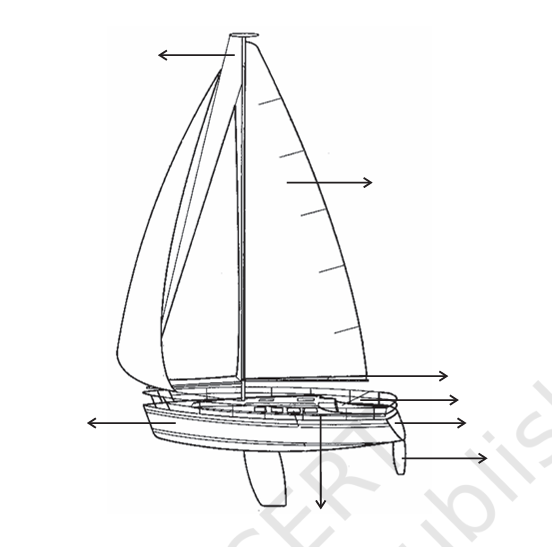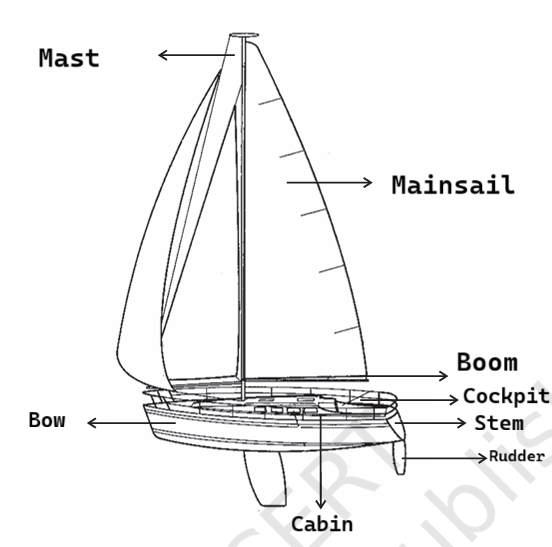
Hornbill | We Are not Afraid To Die Class 11 Questions And Answers Solved | NCERT Solutions & Summary, it is essential for young learners to build a strong foundation in the subject, and CBSE Class 11 English Solutions, Understanding the Chapter thoroughly, helps students grasp key concepts, improve comprehension, and perform well in exams. Also, we provide We Are not Afraid To Die Class 11 Question Answers and Class 11 English Sample Papers.
In this article we will provide you We Are not Afraid To Die Class 11 Summary in English, Hindi and Bengali pdf.
Table of Contents
We Are not Afraid To Die Class 11 Questions And Answers Solved | NCERT Solutions & Summary
We Are not Afraid To Die Class 11 Summary in English: (We Are not Afraid To Die Class 11)
The book is a firsthand account by a 37-year-old entrepreneur who, together with his wife Mary and their kids Jonathan (6) and Suzanne (7), embarked in July 1976 to emulate the historic round-the-world journey of Captain James Cook. Their craft, Wavewalker, was sturdily built and well-equipped.
The trip was without a hitch until Cape Town, where Larry Vigil and Herb Seigler joined them to confront the turbulent Indian Ocean. Shortly after departure from Cape Town, they were hit by relentless gales and gigantic waves. On January 2, they came upon an enormous, almost vertical wave that nearly capsized their boat. The narrator was severely hurt, the deck was destroyed, and the boat started to flood.
In spite of horrific damage, he made temporary repairs using canvas and hatch covers. All hands worked round the clock-pumping water, navigating, and attempting to send out mayday signals. The children demonstrated courage beyond their years: Suzanne, although seriously injured, remained quiet in order not to worry her parents, and Jonathan informed his father that they weren’t scared of dying if only the family were together.
Through sheer willpower and collaboration, the narrator managed to keep the boat buoyant and navigate it to Ile Amsterdam, a small island where there is a French base. Finally, after struggling for days, they spotted the island and were rescued.
Human endurance, hope, family affection, and determination to survive despite everything emerge as the themes in the story.
We Are not Afraid To Die Class 11 Summary in Hindi: (We Are not Afraid To Die Class 11)
यह पुस्तक एक 37 वर्षीय उद्यमी का प्रत्यक्ष विवरण है, जिन्होंने अपनी पत्नी मैरी और अपने बच्चों जोनाथन (6) और सुज़ैन (7) के साथ जुलाई 1976 में कैप्टन जेम्स कुक की ऐतिहासिक विश्व-भ्रमण यात्रा का अनुकरण करने के लिए यात्रा शुरू की थी। उनका यान, वेववॉकर, मज़बूत और अच्छी तरह से सुसज्जित था।
केप टाउन तक यात्रा बिना किसी रुकावट के चली, जहाँ लैरी विजिल और हर्ब सीगलर उनके साथ अशांत हिंद महासागर का सामना करने के लिए शामिल हुए। केप टाउन से प्रस्थान के कुछ ही समय बाद, वे लगातार तेज़ हवाओं और विशाल लहरों की चपेट में आ गए। 2 जनवरी को, वे एक विशाल, लगभग खड़ी लहर से टकराए जिसने उनकी नाव को लगभग पलट दिया। कथावाचक गंभीर रूप से घायल हो गए, डेक नष्ट हो गया, और नाव में पानी भरने लगा।
भयानक क्षति के बावजूद, उन्होंने कैनवास और हैच कवर का उपयोग करके अस्थायी मरम्मत की। सभी हाथ चौबीसों घंटे काम कर रहे थे – पानी पंप करना, नेविगेशन करना, और मेडे सिग्नल भेजने का प्रयास करना। बच्चों ने अपनी उम्र से बढ़कर साहस का परिचय दिया: सुज़ैन, गंभीर रूप से घायल होने के बावजूद, अपने माता-पिता को चिंता न हो, इसके लिए चुप रही, और जोनाथन ने अपने पिता को बताया कि अगर परिवार साथ रहे तो उन्हें मरने का डर नहीं है।
अपनी दृढ़ इच्छाशक्ति और सहयोग से, कथावाचक नाव को तैरते हुए रखने और उसे आइल एम्स्टर्डम, एक छोटे से द्वीप, जहाँ एक फ्रांसीसी अड्डा है, तक ले जाने में कामयाब रहा। आखिरकार, कई दिनों की मशक्कत के बाद, उन्हें वह द्वीप दिखाई दिया और उन्हें बचा लिया गया।
मानवीय सहनशक्ति, आशा, पारिवारिक स्नेह और हर परिस्थिति में जीवित रहने का दृढ़ संकल्प कहानी के विषय बनकर उभरे हैं।
We Are not Afraid To Die Class 11 Summary in Bengali: (We Are not Afraid To Die Class 11)
এই বইটি ৩৭ বছর বয়সী একজন উদ্যোক্তার প্রত্যক্ষ অভিজ্ঞতা, যিনি তার স্ত্রী মেরি, তাদের সন্তান জোনাথন (৬) এবং সুজান (৭) কে নিয়ে ১৯৭৬ সালের জুলাই মাসে ক্যাপ্টেন জেমস কুকের ঐতিহাসিক বিশ্বভ্রমণ যাত্রার অনুকরণে যাত্রা শুরু করেছিলেন। তাদের নৌযান, ওয়েভওয়াকার, ছিল মজবুত-নির্মিত এবং সুসজ্জিত।
কেপটাউন পর্যন্ত এই যাত্রায় কোনও বাধা ছিল না, যেখানে ল্যারি ভিগিল এবং হার্ব সিগলার তাদের সাথে অশান্ত ভারত মহাসাগরের মুখোমুখি হতে যোগ দিয়েছিলেন। কেপটাউন থেকে যাত্রা শুরু করার কিছুক্ষণ পরেই, তারা অবিরাম ঝড় এবং বিশাল ঢেউয়ের কবলে পড়ে। ২রা জানুয়ারী, তারা একটি বিশাল, প্রায় উল্লম্ব ঢেউয়ের মুখোমুখি হয়েছিল যা তাদের নৌকাকে প্রায় উল্টে দিয়েছিল। বর্ণনাকারী গুরুতর আহত হন, ডেকটি ধ্বংস হয়ে যায় এবং নৌকাটি বন্যায় ভেসে যেতে শুরু করে।
ভয়াবহ ক্ষতি সত্ত্বেও, তিনি ক্যানভাস এবং হ্যাচ কভার ব্যবহার করে অস্থায়ী মেরামত করেছিলেন। সকলেই চব্বিশ ঘন্টা কাজ করেছিলেন – জল পাম্প করা, নেভিগেট করা এবং মেডে সংকেত পাঠানোর চেষ্টা করা। শিশুরা তাদের বয়সের বাইরেও সাহসিকতা প্রদর্শন করেছে: সুজান, যদিও গুরুতর আহত, তার বাবা-মাকে চিন্তিত না করার জন্য চুপ করে ছিল, এবং জোনাথন তার বাবাকে জানিয়েছিল যে পরিবার একসাথে থাকলে তারা মৃত্যুকে ভয় পায় না।
অনিচ্ছাশক্তি এবং সহযোগিতার মাধ্যমে, বর্ণনাকারী নৌকাটিকে উচ্ছল রাখতে সক্ষম হন এবং এটিকে ইলে আমস্টারডামে নিয়ে যেতে সক্ষম হন, একটি ছোট দ্বীপ যেখানে একটি ফরাসি ঘাঁটি রয়েছে। অবশেষে, কয়েকদিন ধরে সংগ্রাম করার পর, তারা দ্বীপটি দেখতে পান এবং উদ্ধার করা হয়।
মানুষের ধৈর্য, আশা, পারিবারিক স্নেহ এবং সবকিছু সত্ত্বেও বেঁচে থাকার দৃঢ় সংকল্প গল্পের মূল বিষয়বস্তু হিসেবে উঠে আসে।
Also Read
- Class 11 English NCERT Solutions Hornbill 2025-26 | Chapter wise free pdf answers
- The Portrait of A Lady Class 11 Questions With Answers Solved
Class 11 English Hornbill We Are Not Afraid To Die Questions from Textbook Solved
Understanding the text (We Are not Afraid to Die Class 11)
1. List the steps taken by the captain
- (i) to protect the ship when rough weather began.
- (ii) to check the flooding of the water in the ship.
Answer:
(i) To protect the ship when rough weather began, the captain planned to slow the ship down. The storm jib was dropped, and the mooring rope, which was heavy, was lashed in a loop over the stem. Everything was double-fastened, and they went through the life-raft drill.
(ii) Larry and Herb started pumping out water. The captain stretched canvas and secured waterproof hatch covers across the gaping holes. When the two hand pumps blocked and the electric pump short-circuited, he found another electric pump, connected it to an out pipe and started it.

2. Describe the mental condition of the voyagers on 4 and 5 January.
Answer:
On 4 January, the voyagers were completely exhausted after thirty-six hours of continuous pumping, steering, and struggling against the storm. They were physically tired and mentally stressed, yet there was some relief because the water level had finally been brought under control and they could eat a little food. Still, they were anxious, as the boat was badly damaged and they were uncertain about survival.
On 5 January, their situation again turned desperate when the weather worsened and black clouds gathered. The voyagers were filled with fear and despair, but at the same time, they showed remarkable courage. Jonathan, the little boy, told his father that they were not afraid of dying if they could all be together. This brave statement reflected not only the children’s maturity but also the spirit of unity and determination that gave the family strength to continue fighting for survival.
3. Describe the shifts in the narration of the events as indicated in the three sections of the text. Give a subtitle to each section.
Answer:
- Section One – Preparation and Beginning: The narrator explains his family’s dream of circling the world, their years of training, and the boat Wavewalker. The voyage begins smoothly from England to Cape Town, where two crewmen join them.
- Section Two – Struggle Against the Storm: A huge wave strikes on 2 January, smashing the boat and injuring the narrator. Water floods in, and the crew works endlessly to pump it out. Despite injuries, the children remain brave, and Jonathan tells his father they are not afraid to die if all are together.
- Section Three – Survival and Rescue: Finally, with determination and careful navigation, they reach Ile Amsterdam. The island brings relief and safety.
Talking about the text (We Are not Afraid to Die Class 11)
Discuss the following questions with your partner. (We Are not Afraid To Die Class 11)
1. What difference did you notice between the reaction of the adults and the children when faced with danger?
Answer:
When faced with danger, the adults and children reacted differently but with equal courage. The adults – the narrator, his wife Mary, and the two crewmen Larry and Herb – focused on practical action. They pumped out water, repaired the damaged side with canvas, steered the boat, and worked tirelessly to save Wavewalker. Their reaction was one of responsibility, determination, and physical effort.
The children, Jonathan and Suzanne, could not take part in the physical struggle, but their mental strength was remarkable. Despite injuries, Suzanne did not complain and even made a funny card to cheer her parents. Jonathan expressed maturity beyond his age when he said they were not afraid of dying if they could all be together. Their innocence, courage, and emotional support gave the adults strength to keep fighting.
2. How does the story suggest that optimism helps to endure “the direst stress”?
Answer:
The story suggests that optimism certainly helps to endure the direst stress. The behaviour of the four adults during crisis bears it out. Larry Vigil and Herb Seigler were two crewmen. As the mighty waves smashed the deck, water entered the ship through many holes and openings. Right from the evening of January 2, Larry and Herb started pumping out water. They worked continuously, excitedly and feverishly for 36 hours. It was a result of their continuous pumping that they reached the last few centimetres of water on January 4.
They remained cheerful and optimistic while facing extremely dangerous situations. The narrator did not lose his courage, hope or presence of mind while facing problems. He did not worry about the loss of equipment. He used whatever was available there. His self confidence and practical knowledge helped them to steer out of storm and reach the lie Amsterdam island. Mary stayed at the wheel for all those crucial hours. She did not lose hope or courage either.
3. What lessons do we learn from such hazardous experiences when we are face-to-face with death?
Answer:
Such hazardous experiences teach us valuable lessons about life and human spirit. They show that courage, determination, and teamwork can help us face even the most dangerous situations. We learn the importance of staying calm and never giving up hope, even when death seems close. These experiences also make us realize the power of love, faith, and optimism, as the support of family and companions gives strength to endure hardships. Most importantly, they remind us to value life and live with gratitude.
4. Why do you think people undertake such adventurous expeditions in spite of the risks involved?
Answer:
People undertake such adventurous expeditions despite the risks because of their spirit of exploration and desire to challenge human limits. Many feel a deep urge to discover the unknown, experience nature’s power, and test their own courage and endurance. Such adventures give a sense of thrill, achievement, and fulfillment that ordinary life cannot provide. For some, it is also a way of proving their skills, leaving behind a legacy, or simply living life to the fullest, even if danger is involved.
Also Read
- Class 11 English NCERT Solutions Hornbill 2025-26 | Chapter wise free pdf answers
- The Portrait of A Lady Class 11 Questions With Answers Solved
- A Photograph Class 11 Questions And Answers
Thinking about language (We Are not Afraid to Die Class 11)
1. We have come across words like ‘gale’ and ‘storm’ in the account. Here are two more words for ‘storm’: typhoon, cyclone. How many words does your language have for ‘storm’?
Answer:
Our language has following words for storms:
aandhi (आँधी) , toofan (नाव), Jhanjavat (झँझावत ) , Chakravat (चक्रवात)
2. Here are the terms for different kinds of vessels: yacht, boat, canoe, ship, steamer, schooner. Think of similar terms in your language.
Answer:
In English we say yacht, boat, canoe, ship, steamer, and schooner. In Bengali, similar terms are নৌকা (nouka) for boat, ডিঙি (dingi) for small boat, লঞ্চ (launch) for steamer, and জাহাজ (jahaj) for ship.
3. ‘Catamaran’ is a kind of a boat. Do you know which Indian language this word is derived from? Check the dictionary.
Answer:
The word ‘catamaran’ is derived from the Tamil language. It comes from the Tamil word “kattumaram”, where “kattu” means ‘to tie’ and “maram” means ‘wood’ or ‘tree’. Thus, the original meaning of the word is ‘logs of wood tied together’, which later came to refer to a type of boat.
4. Have you heard any boatmen’s songs? What kind of emotions do these songs usually express?
Answer:
Yes. These songs call upon other sailors to awake, arise and set out to the sea to explore its rich wealth. These songs are full of inspiration and provide moral support to the sad and disappointed boatmen.
Also Read
- Class 11 English NCERT Solutions Hornbill 2025-26 | Chapter wise free pdf answers
- The Portrait of A Lady Class 11 Questions With Answers Solved
- A Photograph Class 11 Questions And Answers
Working with words (We Are not Afraid to Die Class 11)
1. The following words used in the text as ship terminology are also commonly used in another sense. In what contexts would you use the other meaning?

Answer: Here’s how the words from the text can have other common meanings in everyday contexts:
1. Knot:
- Ship sense: A unit of speed for a ship
- Everyday sense: A tied loop in a rope, string, or shoelace.
2. Stern:
- Ship sense: The back part of a ship.
- Everyday sense: Serious, strict, or severe in attitude.
3. Boom:
- Ship sense: A horizontal spar on a ship used to hold sails.
- Everyday sense: A sudden loud noise, or a period of rapid growth.
4. Hatch:
- Ship sense: A small opening on a ship’s deck used to access lower parts of the ship.
- Everyday sense: A small door or opening, often in a floor, ceiling, or wall.
5. Anchor:
- Ship sense: A heavy object used to keep a ship in place.
- Everyday sense: Someone or something that provides stability, security, or grounding.
2. The following three compound words end in -ship. What does each of them mean?

Answer:
- Airship: A powered, steerable flying craft that floats in the air using gas.
- Flagship: The leading or most important ship in a fleet, usually carrying the commanding officer.
- Lightship: A ship that acts as a floating lighthouse, anchored at a dangerous location to guide other ships safely.
3. The following are the meanings listed in the dictionary against the phrase ‘take on’. In which meaning is it used in the third paragraph of the account:

Answer:
In the third paragraph of the account, ‘take on’ is used in the sense of ‘take sb on’ i.e. ‘to employ sb’; “to engage sb’ The words are: We took on two crewmen….to help us….
Things to do (We Are not Afraid to Die Class 11)
1. Given on the next page is a picture of a yacht. Label the parts of the yacht using the terms given in the box.


Answer:

We Are not Afraid To Die Class 11 Short Answer Type Questions And Answers Solved
1. Who were the members of the narrator’s family on the voyage?
Answer: The narrator (a 37-year-old businessman), his wife Mary, son Jonathan (6), and daughter Suzanne (7).
2. What was the name of their boat? Describe it briefly.
Answer: The boat was named Wavewalker. It was a 23-metre long, 30-ton wooden-hulled boat, professionally built and tested for rough weather.
3. What was the purpose of their voyage?
Answer: They wanted to duplicate the round-the-world voyage made by Captain James Cook 200 years earlier.
4. Who joined them at Cape Town and why?
Answer: American Larry Vigil and Swiss Herb Seigler joined them to help tackle the rough seas of the southern Indian Ocean.
5. What happened on January 2 at 6 p.m.?
Answer: A gigantic, nearly vertical wave struck Wavewalker, smashing the deck and filling the boat with water.
We Are not Afraid To Die Class 11
6. How was the narrator injured during the storm?
Answer: His ribs were cracked, his mouth was filled with blood and broken teeth when he was thrown against the wheel and deck.
7. What was Mary’s reaction when the boat started sinking?
Answer: Mary rushed up and screamed, “We’re sinking! The decks are smashed; we’re full of water.”
8. How did the narrator manage temporary repairs on the boat?
Answer: He used canvas, waterproof hatch covers, screws, and hammer to cover the gaping holes on the starboard side.
9. What happened to the pumps during the storm?
Answer: The hand pumps got blocked with debris, and the main electric pump stopped working. Luckily, another spare electric pump under the chartroom worked.
10. How did Suzanne try to comfort her parents despite her injuries?
Answer: She made a funny card with caricatures of her parents and wrote a loving message saying, “Oh, how I love you both. So this card is to say thank you and let’s hope for the best.”
We Are not Afraid To Die Class 11
11. What injuries did Suzanne suffer?
Answer: She had a deep cut on her arm, two black eyes, and a severe head injury that later needed six operations.
12. What did Jonathan tell his father when the situation became desperate?
Answer: He said, “Daddy, we aren’t afraid of dying if we can all be together — you and Mummy, Sue and I.”
13. Why could they not use the main mast for sailing?
Answer: The main rib frames were smashed, and using the main mast would have pulled apart the damaged hull.
14. How did they try to protect the weakened starboard side?
Answer: They improvised a sea anchor using heavy nylon rope and two plastic paraffin barrels to face the oncoming waves with the port side.
15. What did Mary serve after two days without food?
Answer: She found some corned beef and cracker biscuits, which became their first meal in two days.
We Are not Afraid To Die Class 11
We Are not Afraid To Die Class 11 Long Answer Type Questions And Answers Solved
1. Describe the difficulties faced by the narrator and his family on January 2, when their boat was struck by the giant wave.
Answer:
On January 2, around 6 p.m., the narrator and his family faced a terrifying ordeal when an enormous, almost vertical wave struck their boat Wavewalker. The deck was smashed, the starboard side was badly damaged, and water rushed inside. The narrator himself was thrown against the wheel, suffering cracked ribs and broken teeth. Mary screamed that they were sinking, while Larry and Herb worked hard at pumping out water. The children were injured but remained calm. The situation was life-threatening, and the family had to struggle continuously to save the boat from sinking.
We Are not Afraid To Die Class 11
2. How did the narrator and his crew manage to save the boat from sinking?
Answer:
The narrator and his crew showed great presence of mind. First, he repaired the starboard side by stretching canvas and using waterproof hatch covers to block the gaping holes. He also managed to start an electric pump under the chartroom when other pumps failed. The crew worked tirelessly, pumping out water and steering. To protect the weak starboard side, they created an improvised sea anchor with nylon ropes and plastic barrels. Through teamwork, courage, and constant effort, they managed to keep the boat afloat until they reached Ile Amsterdam.
We Are not Afraid To Die Class 11
3. What role did the narrator’s wife Mary and crew members Larry and Herb play during the crisis?
Answer:
Mary, the narrator’s wife, showed immense courage and determination. She steered the boat during crucial hours when the narrator was injured and helped keep everyone calm. Larry Vigil and Herb Seigler, the two crew members, were cheerful and optimistic even in desperate times. They worked tirelessly at the pumps to keep the water under control. Their collective effort and positive spirit kept hope alive and played a vital role in saving the family.
We Are not Afraid To Die Class 11
4. How did the children, Jonathan and Suzanne, display extraordinary courage in the face of danger?
Answer:
Jonathan and Suzanne showed remarkable bravery during the crisis. Despite being only six and seven years old, they remained calm and did not panic. Suzanne, though badly injured with a head wound, arm cut, and black eyes, never complained and even made a funny card to cheer her parents. Jonathan showed maturity far beyond his age when he told his father, “We aren’t afraid of dying if we can all be together.” Their courage, innocence, and positivity gave the parents strength and determination to fight against all odds.

5 thoughts on “We Are Not Afraid To Die Class 11 Questions And Answers Solved | Hornbill | Chapter 2 | Best Solutions”